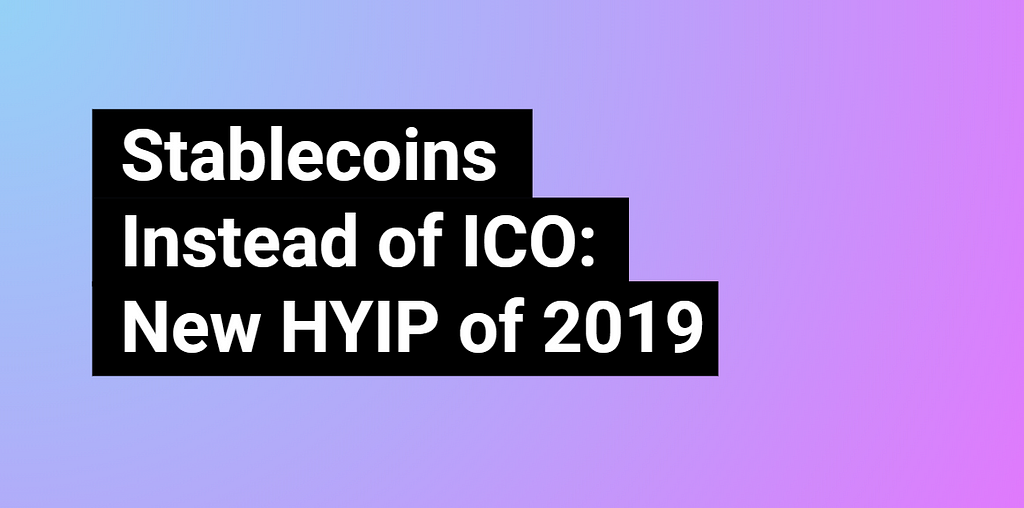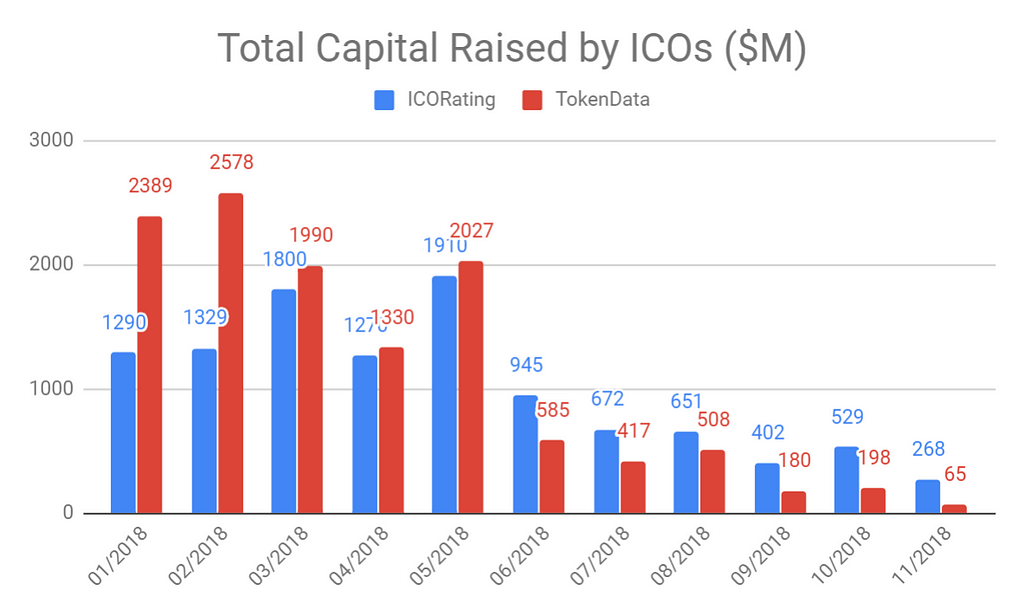Latest news about Bitcoin and all cryptocurrencies. Your daily crypto news habit.
 While ICO volumes have fallen dramatically there is a new trend starting in cryptocurrency market — stablecoins. Tired of volatility, the market is waiting for more than 100 new coins tied to fiat money, cryptocurrency and etc. Will it save the industry from constant up and downs and what is the future for stablecoins?
While ICO volumes have fallen dramatically there is a new trend starting in cryptocurrency market — stablecoins. Tired of volatility, the market is waiting for more than 100 new coins tied to fiat money, cryptocurrency and etc. Will it save the industry from constant up and downs and what is the future for stablecoins?Outgoing ICOs
The era of easy money that could be raised through ICO has come to an end. Such a conclusion is made because of the funds raising dynamics during the year. Many rating agencies and research companies roll out their figures: there are ICORating and TokenData, whose data is close to the truth. Regardless of the calculation parameters, the trend is obvious.
In November, in comparison with the last year most profitable month, ICO funding according to ICORating fell by 86%, and according to TokenData — by 97%. Lack of trust in ICO projects together with the background of a solid amount of scams and dropped cryptocurrencies prices did their job.
However, let’s call it, ICO recession has become a trigger for the one of the cryptocurrency market segments development of of the — stablecoins — cryptocurrencies, the price of which is stable relative to the entire market.
Stablecoins Coming
Look through the history, when the market falls, investors shift to more stable assets. And it’s not about the cryptocurrency market, the volume of which is not even comparable to the capitalization of Apple or, say, Amazon. It’s about the of the global capital market characteristics (specifics).
There were record investments to US Treasury securities during the crisis of 2008, which were traditionally regarded as the most risk-free investment option. The same is true with cryptocurrency — during periods when there were the sharpest collapses in Bitcoin and Ethereum, there were jumps in purchases of stablecoins.
Much more compelling evidence of the stablecoins growing popularity in the number of new startups in this area.
According to a study of the popular crypto wallet Blockchain.com, despite the fact that there are currently 23 stablecoin projects, 34 more projects are under development.
It is important to note that one such startup can release several stable cryptocurrencies at once when one, for example, will be tied to the dollar, and the other to the euro. For this reason, the real number of stablecoins that will appear in the near future may be more than 50.
The growth in the number of new projects is associated not only with the growing market demand for stable cryptocurrency assets, but also with the poor reputation of the most popular stablecoin today — Tether. In theory, the value of its USDT token should be equal to 1 USD. Although in October, amid problems with fiat currency collateral, the USDT rate reached $0.92, which is 8% lower than the required price.
Stablecoins Future
According to Blockchain.com, the total capitalization of existing stablecoin companies is $3 billion, i.e. about 2% of the cryptocurrency market. Taking into account the needs of the financial industry in stable, low-risk and decentralized assets, the figure of 2% has great growing potential. There are 4 types of stablecoins:
- Stablecoins tied to fiat money
- Algorithmic stablecoins
- Stablecoins tied to real-world commodity trade
- Stablecoins tied to cryptocurrencies
1. Stablecoins Tied to Fiat Money
This type of stablecoin is the easiest to explain to people far from cryptocurrency. That kind of coin is tied to fiat money.
For example, Tether, whose USDT token is tied to the U.S. dollar. This is the most popular stablecoin, which by capitalization is in the top 10 world cryptocurrencies. 66% of existing stablecoins are tied to the U.S. currency. But the industry’s future is hardly behind that kind of tool.
In fact, all stablecoins tied to fiat money are nothing more than a digital bank receipt. This is an electronic evidence that a particular bank has a specific amount of money in dollars, euros, rubles or other fiat money. For some cryptocurrencies, these receipts do not raise doubts (Gemini). Аnd that is not O.K. for everyone, taking Tether as an example. All its billion-dollar collateral in a dubious offshore Deltec bank.
Such stablecoins are too centralized and the founders of these coins can “burn” or “freeze” tokens at any time: as seen in their own documents (for example, smart contract code of Gemini stablecoin project).
2. Algorithmic Stablecoins
Algorithmic stablecoins are fully digitalized and independent from any types of collateral, with their supply and target price controlled only by the code. Such stablecoins are fully decentralized with no third party involved and highly scalable as they don’t require additional collateral as the supply increases.
However, there are very few working examples of such projects. Most recently, one of the developers of the algorithmic coin Basis, who have raised $133 million, announced his intention to return the money and close the project (it should be noted that Basis didn’t even have time to start, remaining at the White Paper stage).
3. Stablecoins Tied to Real-World Commodity Trade
This type of stablecoin is a kind of bridge between the real economy, the trade between countries and cryptocurrencies, which carry the principles of decentralization and transparency. Unlike coins tied to fiat money or algorithms, their value is tied to a turnover.
One of such projects on its own blockchain is MILE, which includes MILE and XDR coins. If XDR is a stablecoin, which is tied to SDR (International Monetary Fund Special Drawing Rights, the value of which has changed by 11% over the past 30 years), MILE is a volatile coin and XDR demand index.
4. Stablecoins Tied to Cryptocurrencies
These stablecoins ties its value to other cryptocurrencies. It seems illogical to seek exchange rate stability where it doesn’t exist at all — on the cryptocurrency market. However, back in 2013, BitUSD was launched, a pioneer and the brightest representative of stablecoins with a cryptocurrency colateral. The stability of the coin provides excessive collateral, which neutralises the price fluctuations.
These stablecoins’ future is uncertain, since they don’t interact with the real world, separate from the real economy. As for BitUSD, the project founder has left it a long time ago. There is no one to develop it, while other working crypto-collateral stablecoin projects are hardly found.
Conclusion
In 2019, liquidity of cryptocurrency, used in the real economy, will increase greatly. That will attract large institutional capital to the market.
Today hundreds of different coins are dead, which means there is no way of becoming a value without a use in the real economy. In order to have a value for the real sector, a coin must definitely have a stable exchange rate. People do not need “pumps and dumps” so much as goods trading, as well as an efficient and cheap way to transfer money.
The most popular cryptocurrency, Bitcoin, is not suitable for the real economy sector due to its volatility, although it is not going anywhere. The niche will be occupied by only those stablecoins, which are decentralized, open and convenient for ordinary people and investors.
Stablecoins Instead of ICO: New HYIP of 2019 was originally published in Hacker Noon on Medium, where people are continuing the conversation by highlighting and responding to this story.
Disclaimer
The views and opinions expressed in this article are solely those of the authors and do not reflect the views of Bitcoin Insider. Every investment and trading move involves risk - this is especially true for cryptocurrencies given their volatility. We strongly advise our readers to conduct their own research when making a decision.
